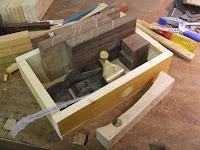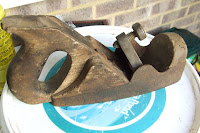
Well with me knocking out planes left right and centre I guess you are board of hearing about it. So let's talk about some tools.
Sorry, I meant tools I use for making planes ;)
First up, the Planemakers Float.
This is a cross between a rasp and a saw, a coarse toothed tool that comes in a variety of shapes and sizes. And indeed, is a tool that you can easily make yourself. In the photo you can see some flashy Lie-Nielsen/Clark and Williams floats. And if you look to the left you will see the skew float I made last week, complete with a file handle.
So how do you use them (and for what?)
These tools excel at opening up partially excavated areas - imagine the area in front of the wedge abutments in a bench plane. Or the wedge mortise in a moulding plane. Drill a hole at the bed angle and then a second one on the breast line - the float then opens the mortise out and squares the sides. And if you are making a skewed iron plane you need a float that has its side skewed by the same amount - this takes all the effort out of this kind of work as it is a self-jigging tool that almost guarantees a perfect result. Just throw in a bit of practise and voila!
You can easily knock up a float in 30 minutes - all you need is a piece of steel (preferably tool steel), a hacksaw and some files. If you've ever tried to sharpen a handsaw then you can make a float no problem! I even found that the random shaping of the teeth I filed in helped to make a smoother cut - bizarre but true! A file handle makes it safe and comfortable to use or you could make your own.
So what are those cheap and nasty looking chisels doing in the photo, you ask?
Tool number two is the Scraper Chisel.
To convert a regular chisel into a scraper takes little work - present the cutting edge squarely into a grinder to flatten the tip a little. The burr raised by the grinder can be left as it helps the cut (this may be familiar if you use scrapers for lathe work). And that's it!
Use the chisel to clean up difficult to reach areas (and there are plenty in a plane!). The back of the chisel is kept flat on the surface and the tip takes fine shavings - it's so good you can't believe it works!
Both of these tools sound simple to use, and they are. But what you can't imagine is how much easier they make the task of planemaking. They literally have transformed the way I make planes, making certain operations quicker and more accurate.
So have a go at making one or both of these tools - you never know where they may come in handy.
Cheers
Philly





